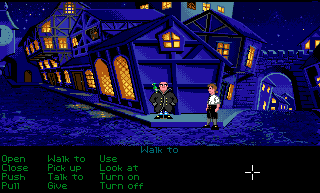
The Secret of Monkey Island and most other adventure games relied on this kind of landscape shot.
I’ve touched on this topic before. I talked briefly about Alone in the Dark‘s revolutionary approach to cameras in my article about the history of the modern survival horror game, and I mentioned the relationship between fixed camera systems and character-centric control schemes in a recent provocative post. But it’s such an interesting topic that I thought I’d devote a post or two to it.
To understand how the horror genre was so influential in developing the visual systems now used by a wide variety of genres, it’s important to understand what the state of the art before horror games came along and why change was necessary. In the late 1980s and early 1990s, adventure games ruled the PC game market. Most of them, like the seminal The Secret of Monkey Island, were built upon flat landscapes populated by sprites. This was enough to show off the game world and the people in it, but the technology wasn’t sufficient to frame shots dramatically.
So

In games like Tomb Raider, “forward” is defined by the camera.
But in transitioning from 2D scenes to 3D scenes, the developers of Alone in the Dark and Resident Evil faced a problem: how best to translate 2D input from the keyboard or controller into 3D space. After all, arrow keys or a D-pad can only represent two axes of movement; the software must pick a heuristic for translating that motion into 3D space. The common heuristic used by most 3D games then and now is to define a vector in 3D space that is “forward.” Tomb Raider, which shipped around the same time Resident Evil was hitting the shelves, used one of the first over-the-shoulder cameras and worked by assuming that the direction the camera was pointing was the direction that Laura Croft would move if the player pressed “up” on their controller. The mapping from 2D controller input to 3D movement was thus a projection along the orientation of the camera. As long as the camera stays generally behind the player’s character, “up” on the control stick will always mean “run forward towards the horizon.” Interestingly, this scheme

In games like Resident Evil, “forward” is defined by the character.
But Alone in the Dark and Resident Evil do not use cameras that are always behind the player. The whole point of Alone in the Dark’s camera system is to provide interesting and affecting points of view for the camera; the system would be moot if the camera were required to simply look in the same direction as the player’s character. So both games opted for the “tank control” model, where player input is mapped to the character’s orientation rather than the camera’s. In this scheme “forward” can be defined independently of the camera–up on the control stick will always cause the player to run in the direction that he is currently facing. By using this system the developers of Alone in the Dark and Resident Evil were able to mix 3D motion with dramatic cameras, and though the result was confusing and carried a high learning curve, the effect ended up being worth it to a huge number of gamers.
In the next post I’ll continue this discussion by talking about games in the late 1990s that made incremental improvements on the Alone in the Dark/Resident Evil model. I’ll also talk about how the model has changed over time, how more recent games have tried to deal with the need to move in 3D space with an unpredictable view point, and which titles now represent the state of the art.
cool article
What I always found interesting is that the Silent Hill series (1-3)uses the method of camera angles and character movement (for the most part like in Resident Evil), but at the same time allowing you to adjust the camera to face in the same direction as the character rather than everything being defined and totally fixed. Though, that’s not true in every area- some are fixed but it is generally angled for a specific, dramatic effect.
I guess to me the big difference is how it makes me feel as far as the creepiness of the games – The camera angles in Resident Evil keep me worry about what monster I might run into because I can’t see where I’m going, or in Silent Hill the cameras allow me to see more of the creepy details in the scenery itself.
Can’t wait to read the next part!
I visit your site nearly every day, but don’t comment enough. Just wanted to say I always enjoy the articles you write on here, even if I don’t leave a comment to say so.
(And personally, I’m still adjusting to new, sophisticated style of movement…my brain still is wired to “Up = Forward,” not “Where character is facing = forward.”)
advance sorry for this silliness, but:
that picture of Lara is *terribly* freudian 😛
> feighnt
Actually, I suspect that’s by design, given the nature of the franchise. There are certain games that came out around that time that made it a point to have the camera centered on the protagonist’s ass.